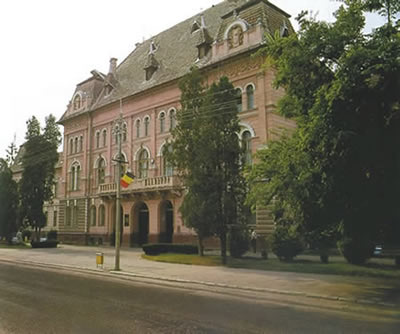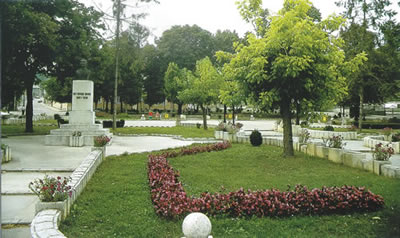
|
|
The
city is located in the Târnave plateau, on the
middle course of the Târnava Mica River, from
the river meadow to the right side of the valley. Presently,
it covers also the left bank of Târnava Mica including
the ancient Bozias village. It is located also in a
major communication crossroads: Târnaveni is the
starting point of the auto routes to Blaj, Iernut, Târgu
Mures, Sovata, Medias. The Blaj- Praid railway also
crosses the city.
The archaeological research
proved the presence of human communities in these parts
as dating from times immemorial. In 1921, traces of
a Neolithic settlement were discovered; a collection
of 135 imperial Dinars and two silver balls were found.
The place was historically certified in 1279, under
the name of terra Dychen Sent Marton (Diciosânmartin),
in a land relocations and ownership document.
In 1502, the place was
mentioned as borough - oppidum, as a part of Cetatea
de Balta fields, owned in the 15th-16th centuries by
Moldavian rulers- Stephen the Great, Petru Rares and
others. Since vineyards covered the majority of the
cultivated land, it came to be known as the " vine
country" - Weinland. For a few centuries until
the half of the XX century, the city proved to be of
a great regional interest, becoming even the capital
of a shire (Târnava shire), or a county capital
(Târnava Mica County), alternating this attribute
with Cetatea de Balta or with Blaj.
|
 |
| Chemistry
Highschool from Tirnaveni |
| |
 |
| The
park in front of Tirnaveni townhall, with the bust
of Octavian Goga |
|
The
last years of the 19th century and the first years of
the 20th century marked the urban evolution of the place,
since many administrative and social-economic buildings
were erected. In 1866 it became the Târnava shire
capital. It was during those years that the administrative
palace and the hospital were built; the great doctor C.I.
Parhon used to consult patients here, his family originating
from Cetatea de Balta.
In 1912, the place was declared
town, and in 1941 it received the name of Târnaveni.
The discovery of methane
gas radically changed the city history. Gas was introduced
in houses in 1915 and, after the war, a calcium carbide
and calcium cyanamide factory was set up, followed by
the Nitrogen company and later by a soot black factory.
The inhabitants brought their huge contributions to the
events of the 20th century, taking part in the Great National
Assembly in Alba-Iulia , on the 1st of December, 1918.
In 1936, an installation of synthetic ammonia production
was set in Târnaveni, the first of this type in
the world. Later, the company switched to warfare production.
World War II left deep traces in the lives of the inhabitants:
230 Romanian heroes are resting in the local cemetery.
After the war, the town industry witnessed a continuous
development. In 1957, for the first time in the country,
vinyl polychlorinate was produced here. A modern glassware
factory - Gecsat - is situated in the southeast area,
producing a wide range of export products.
Great historical and cultural
personalities were involved in the life of Târnaveni.
The coryphaeus of " Scoala ardeleana"("Transylvanian
School"), Petru Maior, is a native of the town. Historians
state that his father, Gheorghe Maior, lived in 1750 in
Târnaveni, serving as a priest in the Seuca parish.
During the 1848-1949 Revolution, Târnaveni was a
part of the 3rd Legion, Cetatea de Balta, of Avram Iancu's
army. Vasile Moldovan, the great fighter for national
emancipation, was the prefect. After the defeat, he settled
in Bozias, where one can find his tomb. According to George
Calinescu, Mihai Eminescu might have passed through Târnaveni,
on his way to Blaj (1866), staying at the central wine
cellar.
In 1966, the Museum of History
was settled, having archaeology, ethnography, nature sciences
and numismatics departments. Târnaveni became a
municipality on the 5th of November 1998. The town has
interesting tourism sites, such as: the " Corona"
forest, located on the inter-river Mures- Târnava
Mica, the Unitarian Church built in gothic style in the
13th century, redecorated in 1599, (the church owns a
silver glass from 1636, a silver plate and a bell dating
from 1678), the wooden Christian Church, brought from
the Cornesti village, whose interior was painted by Nicolae
Pop. The Bozias School was set up in 1780.
|
|
|
|

